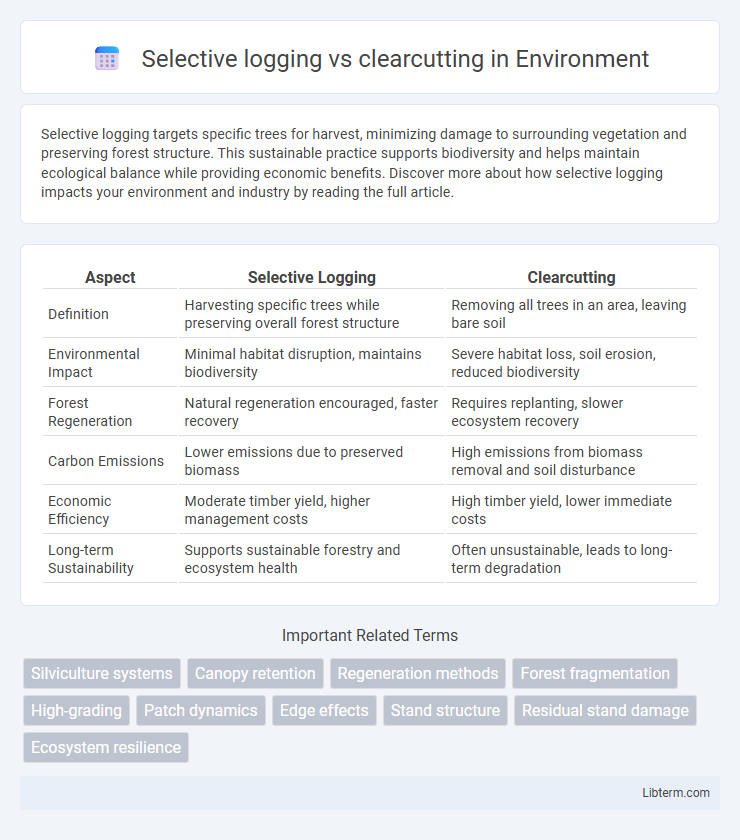Selective logging targets specific trees for harvest, minimizing damage to surrounding vegetation and preserving forest structure. This sustainable practice supports biodiversity and helps maintain ecological balance while providing economic benefits. Discover more about how selective logging impacts your environment and industry by reading the full article.
Table of Comparison
| Aspect | Selective Logging | Clearcutting |
|---|---|---|
| Definition | Harvesting specific trees while preserving overall forest structure | Removing all trees in an area, leaving bare soil |
| Environmental Impact | Minimal habitat disruption, maintains biodiversity | Severe habitat loss, soil erosion, reduced biodiversity |
| Forest Regeneration | Natural regeneration encouraged, faster recovery | Requires replanting, slower ecosystem recovery |
| Carbon Emissions | Lower emissions due to preserved biomass | High emissions from biomass removal and soil disturbance |
| Economic Efficiency | Moderate timber yield, higher management costs | High timber yield, lower immediate costs |
| Long-term Sustainability | Supports sustainable forestry and ecosystem health | Often unsustainable, leads to long-term degradation |
Understanding Selective Logging
Selective logging involves harvesting specific trees while preserving the overall forest structure, promoting biodiversity and reducing environmental impact compared to clearcutting, which removes all trees in an area. This method supports natural regeneration, maintains wildlife habitats, and helps sustain forest ecosystem services such as carbon storage and soil protection. Implementing selective logging requires careful planning and monitoring to minimize damage to residual trees and ensure long-term forest health.
What Is Clearcutting?
Clearcutting is a forestry practice where most or all trees in a designated area are uniformly cut down, resulting in an open canopy and exposing the soil. This method contrasts with selective logging, which involves harvesting specific trees while preserving the surrounding forest structure to maintain biodiversity and ecosystem stability. Clearcutting can lead to increased soil erosion, habitat loss, and altered microclimates, affecting forest regeneration and wildlife populations.
Key Differences Between Selective Logging and Clearcutting
Selective logging involves harvesting specific trees based on criteria like species, size, or health, preserving overall forest structure and biodiversity. Clearcutting removes all trees in a designated area, leading to significant habitat disruption and increased soil erosion. The key differences lie in their ecological impact, with selective logging promoting sustainable forest management while clearcutting often results in greater environmental degradation.
Environmental Impacts of Selective Logging
Selective logging minimizes environmental disruption by preserving the forest canopy and maintaining biodiversity, which helps sustain wildlife habitats and soil stability. This method reduces carbon emissions compared to clearcutting, supporting climate regulation and promoting forest regeneration. Selective logging also decreases erosion and water runoff, protecting watershed health and aquatic ecosystems.
Environmental Consequences of Clearcutting
Clearcutting causes significant environmental consequences, including loss of biodiversity, soil erosion, and disruption of water cycles. Unlike selective logging, which maintains forest structure and habitat, clearcutting removes all trees in an area, leading to habitat destruction and increased carbon emissions. This practice also reduces soil fertility and increases the risk of sedimentation in nearby water bodies, negatively impacting aquatic ecosystems.
Effects on Forest Biodiversity
Selective logging preserves forest biodiversity by maintaining the structural complexity and habitat diversity essential for various species, limiting edge effects, and sustaining understory growth. Clearcutting drastically reduces biodiversity by removing all vegetation, causing habitat loss, soil erosion, and microclimate changes that disrupt species survival and migration. Studies show selective logging supports higher species richness and ecosystem resilience compared to the homogenizing impacts of clearcutting on forest ecosystems.
Carbon Sequestration and Climate Implications
Selective logging preserves a substantial portion of forest canopy, maintaining higher carbon sequestration rates compared to clearcutting, which removes nearly all vegetation and releases stored carbon rapidly. Forests subjected to selective logging retain more soil carbon and continue to act as carbon sinks, mitigating climate change effects more effectively than clearcut areas that become carbon sources for decades. The reduced disturbance of selective logging supports biodiversity and long-term ecosystem resilience, crucial for sustaining climate regulation services.
Economic Considerations of Logging Methods
Selective logging preserves valuable timber by harvesting specific trees, reducing immediate revenue but supporting long-term forest productivity and sustainable income. Clearcutting maximizes short-term economic gain through the rapid removal of all timber, lowering operational costs but potentially leading to soil degradation and costly reforestation efforts. Economic assessments weigh the upfront profits of clearcutting against the sustained, lower-risk returns from selective logging, impacting forest management decisions and market stability.
Sustainable Forestry Practices
Selective logging preserves forest structure and biodiversity by removing specific trees, minimizing environmental impact, and promoting natural regeneration. Clearcutting removes all trees in an area, resulting in habitat loss, soil erosion, and decreased carbon sequestration, often requiring replanting to restore forest cover. Sustainable forestry practices prioritize selective logging to maintain ecosystem services, support wildlife habitats, and enhance long-term forest resilience.
Choosing the Right Approach for Forest Management
Selective logging preserves biodiversity by removing specific trees, minimizing ecosystem disruption and promoting natural regeneration; it suits forests requiring long-term sustainability and habitat protection. Clearcutting maximizes timber yield and reduces short-term costs, but it significantly alters habitat structure and soil stability, making it appropriate primarily for fast-growing plantations or areas planned for redevelopment. Effective forest management balances ecological health and economic goals by assessing site-specific conditions, species characteristics, and conservation priorities to determine the optimal harvesting method.
Selective logging Infographic

 libterm.com
libterm.com